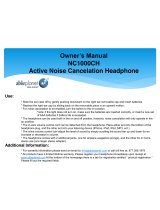
OSHA GUIDELINES FOR NOISE EXPOSURE LIMITS
The Occupational Safety Health Administration (OSHA) has issued
headphone usage recommendations for maximum daily exposure and
sound pressure levels [measured in decibels (dB)]. A decibel is a unit
of sound measurement that increases exponentially with volume. For
example, conversational speech is typically around 60dB and a rock
concert in a stadium is often about 110dB.
FCC NOTICE
This device complies with Part 15 of the FCC Rules. Operation is subject
to the following two conditions: (1) this device may not cause harmful
interference, and (2) this device must accept any interference received,
including interference that may cause undesired operation.
FCC ID: SVC-NADHP70 CMIIT ID: 2017DJ7909
This device complies with Industry Canada licence-exempt RSS
standard(s). Operation is subject to the following two conditions: (1)this
device may not cause interference, and(2) this device must accept any
interference, including interference that may cause undesired operation
of the device.
Radio Frequency Exposure Statement for IC
The device has been evaluated to meet general RF exposure requirements.
The device can be used in mobile exposure conditions. The min separation
distance is 25mm.
WARNING!
Warnings or announcements may be unnoticed when you are
using the headphones. You should be aware of ambient sounds
while wearing the headphones, and recognize them as needed.
Long-term exposure to loud music may cause permanent hearing
damage.
Do not attempt to modify this product as it could result in personal
injury and/or product failure.
If water or other foreign substances enter inside the device, re or
electric shock may result.
CAUTION
Changes or modications to this equipment not expressly approved
by NAD Electronics for compliance could void the user’s authority to
operate this equipment.
Regulatory Information
Operating Temperature Range: 5°C – 40°C
Operating Frequency Range: Bluetooth 2.4G
Max Output Power: 7.8mW
Input Rating: 5VDC, 1A
Battery Rating: 3.7V, 600mAh
Charging Time: 4 hours
Weight: 330 grams
Is in compliance with the essential requirements and other relevant
provisions of Directive 2014/53/EU.
Date of Manufacture: The second digit in the serial number indicates the
year of manufacture; “7” is 2017.
Responsible Party: Lenbrook Industries Limited. 633 Granite Court,
Pickering, Ontario, Canada L1W 3K1. Phone: (905) 831-6333,
Facsimile: (905) 831-6936
Removal of the rechargeable lithium ion battery in this product should
be conducted only by a qualied professional. Please contact your
local NAD Electronics Dealer or visit the Customer Support section at
NADelectronics.com for further information.
The Bluetooth® word mark and logos are registered trademarks owned
by Bluetooth SIG, Inc. and any use if such marks by NAD Electronics is
under license.
The N-Mark is a trademark or registered trademark of the NFC Forum,
Inc. in the United States and in other countries.
Precautions for use
• To prevent possible hearing damage, do not listen at high
volume levels for long periods
• These headphones should only be connected to a USB interface of
version USB2.0 or higher
• Risk of explosion if the battery is replaced by an incorrect type,
dispose of used batteries according to the instructions.
• Be sure to read the Owner’s Manual of the device that you want to
connect to these headphones.
• Check the volume settings when using the headphones when in
public places and ensure that you do not disturb people around you.
• These headphones are not guaranteed to work with all combinations
of Bluetooth devices/mobile phones.
• These headphones do not support a connection with all Bluetooth
devices/mobile phones.
• Bluetooth wireless technology can communicate up to approximately
10 m. Obstructions (people, metallic objects, walls, etc.) and radio
wave conditions aect the actual range.
• The Bluetooth device that you want to connect with must support
the same prole as these headphones in order to use the Bluetooth
function. For details on proles that the Bluetooth device is
compatible with, see the Bluetooth device Owner’s Manual.
• Due to features of Bluetooth wireless technology, playback of audio
on the headphones is slightly delayed compared to the playback on
the transmitting device.
• Do not use your headphones while driving.
• Remove the headphones immediately if you experience a warming
sensation or loss of audio.
• Do not use mobile phone adaptors to connect these headphones to
airplane seat jacks, as this could cause overheating and result in injury
or property damage.
• The headphones and accessories contain small parts which may be a
choking hazard. Not suitable for children under age 3.
• This product contains magnetic material. Consult your physician on
whether this might aect your implanted medical device.
• Use this product only with an agency approved power supply which
meets local regulatory requirements (e.g., UL, CSA, VDE, CCC).
• Do not expose products containing batteries to excessive heat (e.g.
from storage in direct sunlight, re or the like).
NOTES ON ENVIRONMENTAL PROTECTION
At the end of its useful life, this product should not be
disposed of with regular household waste and should be
returned to a collection point for the recycling of electrical
and electronic equipment. The symbol on the product,
user’s manual and packaging point this out.
The materials can be reused in accordance with their markings. Through
re-use, recycling of raw materials, or other forms of recycling of old
products, you are making an important contribution to the protection of
our environment.
Your local administrative oce can advise you of the responsible waste
disposal point.
IMPORTANT SAFETY INSTRUCTIONS
90dB 8 hours
95dB 4 hours
100dB 2 hours
105dB 1 Hour
110dB 30 minutes
115dB 15 minutes
120dB Avoid as damage may occur
2









